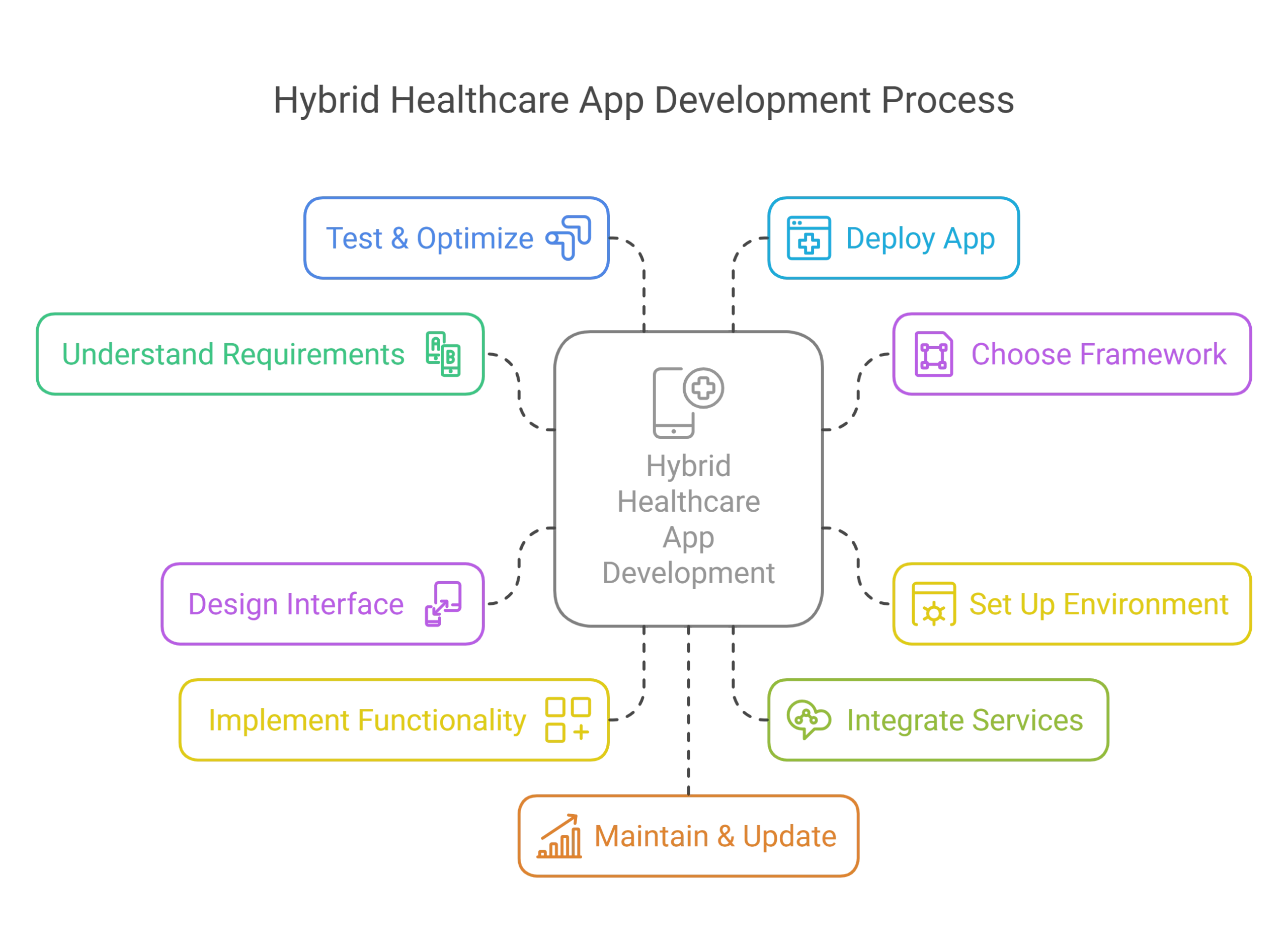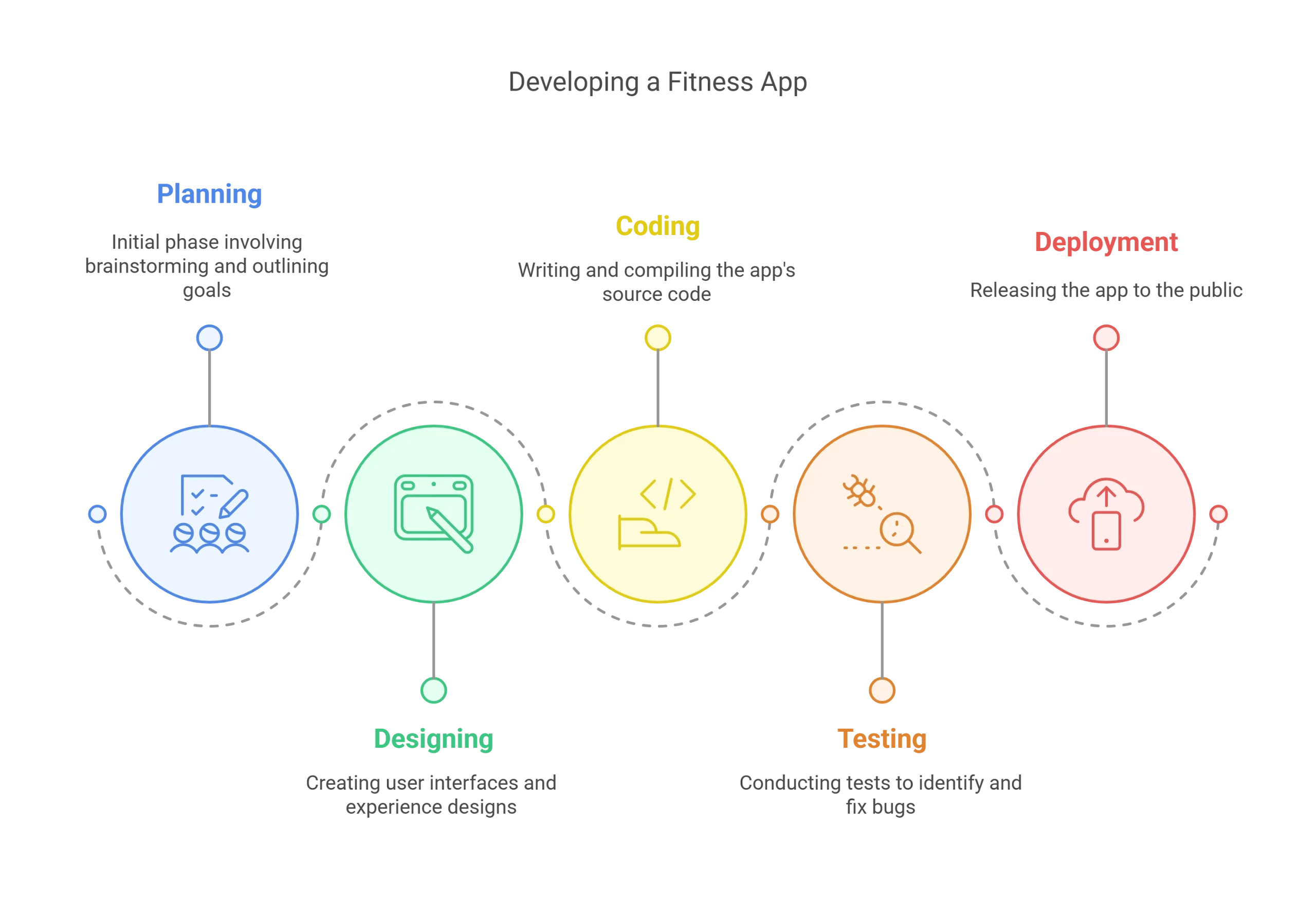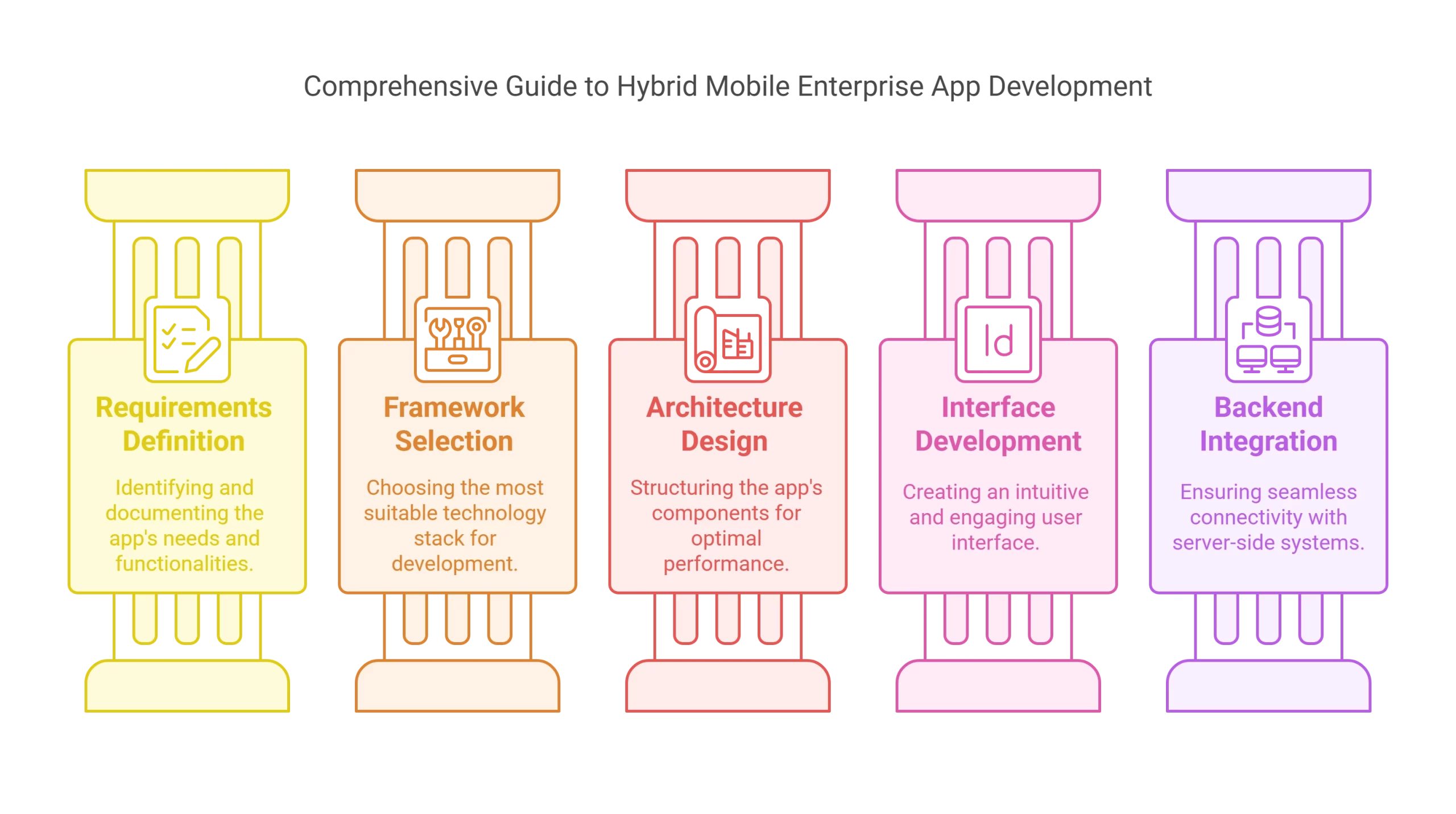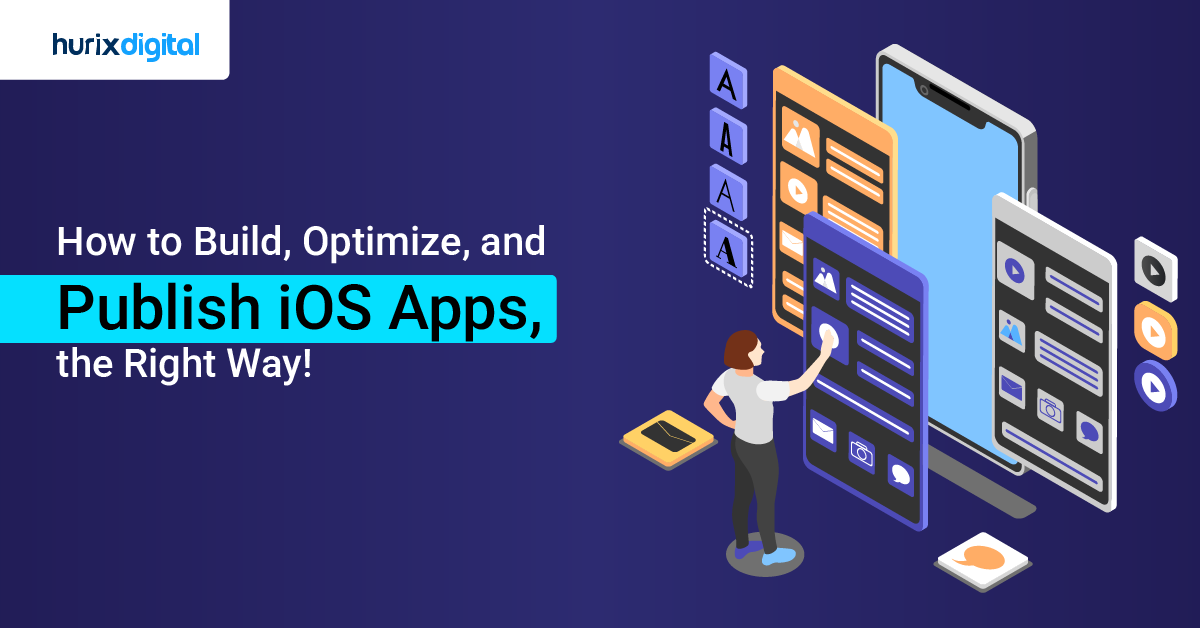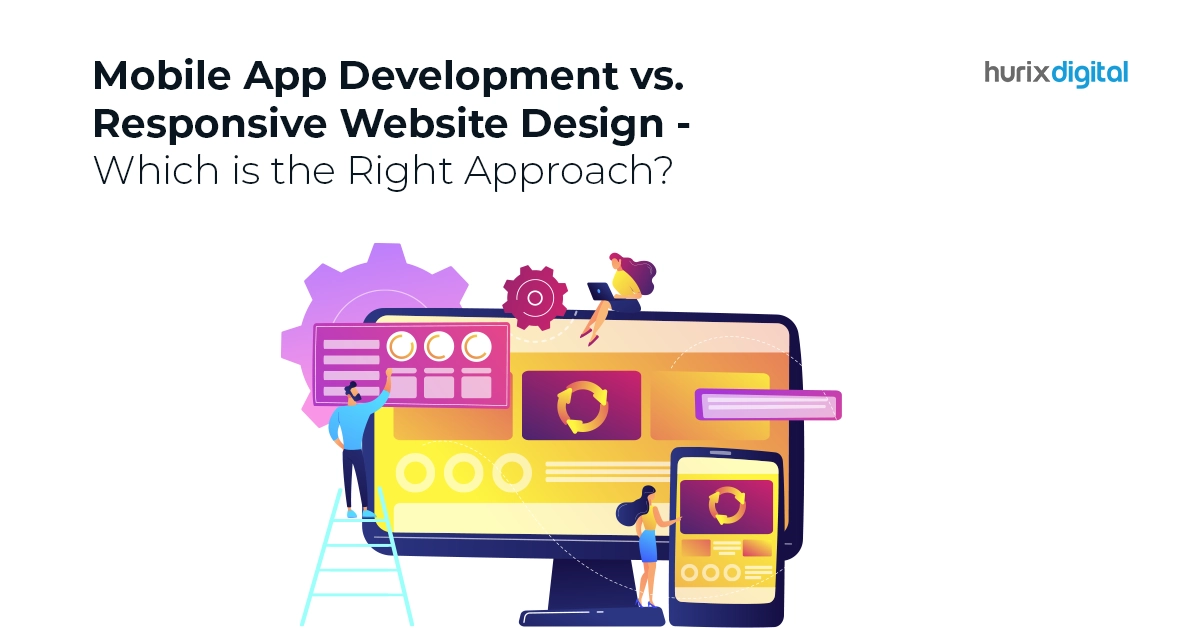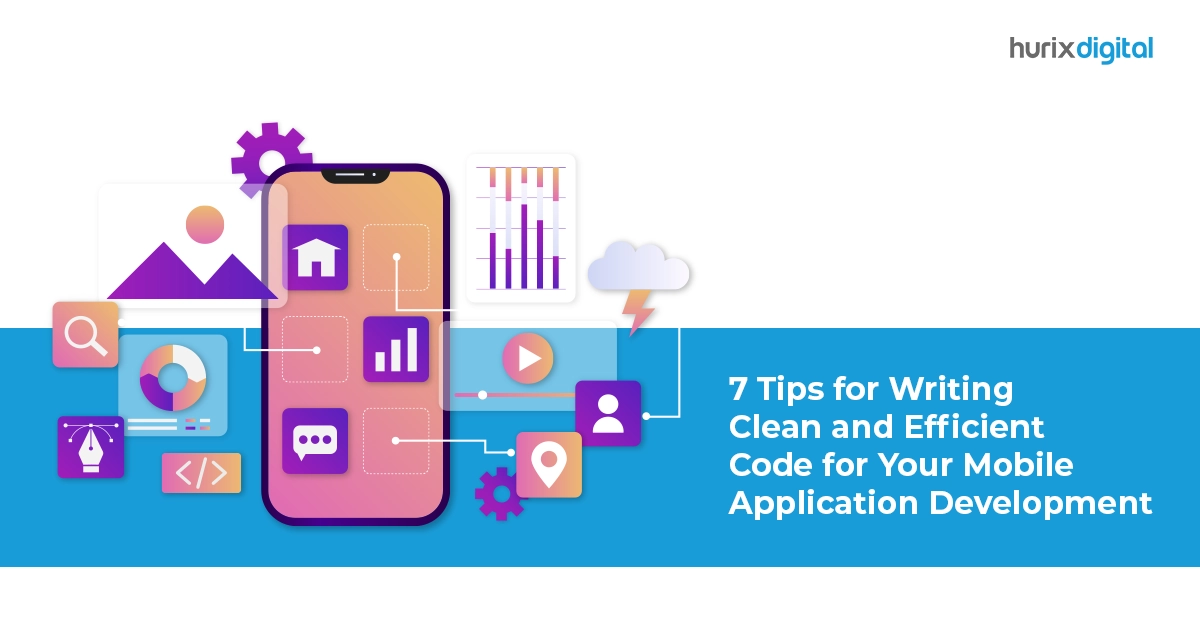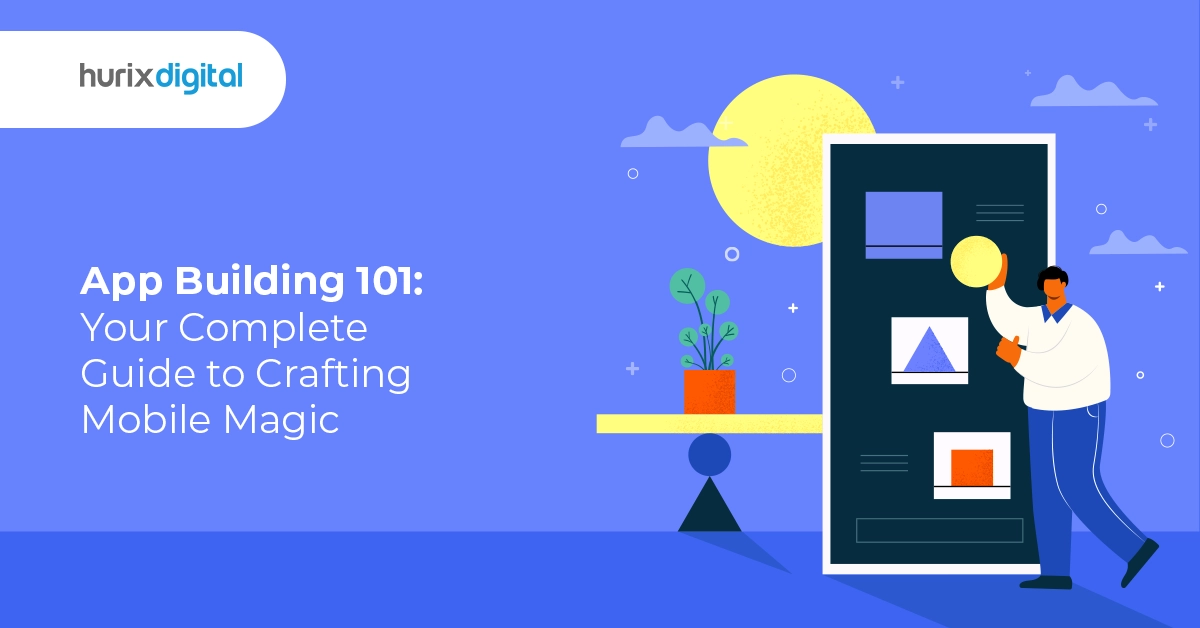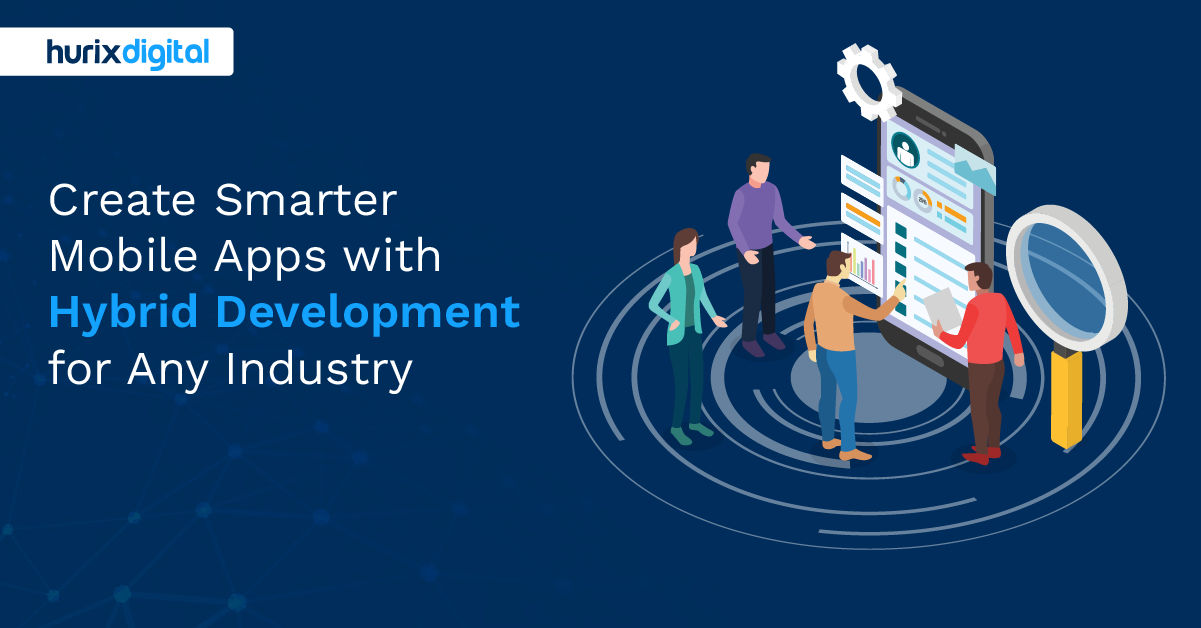
Create Smarter Mobile Apps with Hybrid Development for Any Industry
Summary
Hybrid mobile apps offer businesses a cost-effective, cross-platform solution, blending web and native technologies for seamless user experiences. This blog explores hybrid app development, key benefits, and a step-by-step guide to building powerful apps in industries like healthcare, fitness, and enterprise. Learn how to optimize performance, security, and user engagement.
Mobile apps have become an integral part of our daily lives, catering to various needs, from communication to entertainment and business transactions to productivity. According to a report, the global development market size of mobile applications is anticipated to reach $777.4 billion by 2032 with a CAGR of 20.4%. Within this market, with an increasing number of businesses choosing this approach in building their mobile applications, hybrid mobile apps are gaining prominence.
Hybrid mobile application development maintains an excellent balance between native and web applications. It leverages web technologies such as HTML5, CSS3, JavaScript, etc., which can be used for developing cross-platform codebases for apps capable of running on multiple OSs.
Nevertheless, like any other development methodology, there are advantages and disadvantages of using hybrid mobile apps development that should be considered before starting a project.
In this blog post, we show how you, as a developer, can use different approaches to build powerful apps across industries like healthcare, fitness, enterprise, and gaming.
Table of Contents:
- What are Hybrid Apps, and How Do They Differ from Native Apps?
- Why Use Hybrid Apps for Healthcare App Development?
- A Step-by-Step Guide to Hybrid Healthcare App Development
- Understand the Requirements of a Healthcare App
- Choose a Hybrid Framework
- Set Up the Development Environment
- Design the User Interface
- Implement Core Functionality in the App
- Integrate APIs and Backend Services
- Test and Optimize of the App
- Deploy Your Healthcare App
- Maintain, Update, and Train Users on Your App
- Gather Feedback and Iterate
- What are the Key Features of a Mobile Fitness App?
- Step-by-Step Guide to Develop a Fitness App
- Building a Hybrid Mobile Enterprise App
- How to Create a Hybrid Mobile Gaming App?
- Final Thoughts
What are Hybrid Apps, and How Do They Differ from Native Apps?
The basic design of hybrid mobile apps makes them work on all main operating platforms such as Android, iOS, and Windows. These apps contain both web-based and native parts for universal compatibility.
Each hybrid application needs specific tools that help it work between the browser and native system easily though it has a single code base to run across both platforms.
Each native app needs development for both operating systems to utilize unique platform advantages. Facebook and Google Maps display clear examples of separate versions built for each smartphone platform.
Why Use Hybrid Apps for Healthcare App Development?
Using hybrid apps for mobile healthcare app development offers several advantages, making them a viable choice for many developers and healthcare organizations.
Following are the top three reasons hybrid apps are often chosen for mobile healthcare app development:
1. Cross-Platform Compatibility
Hybrid apps allow developers to write code once and deploy it on multiple platforms (iOS and Android). This significantly reduces mobile application development time and effort compared to building separate native apps for each platform.
2. Faster Development of the App
Hybrid frameworks like React Native and Flutter enable faster development through hot reloading, allowing developers to see instant changes during the coding process.
3. Cost-Effectiveness
Building a hybrid app is often more cost-effective than developing separate native apps for each platform. Development teams can share resources, including developers and code, between iOS and Android projects.
A Step-by-Step Guide to Hybrid Healthcare App Development
Creating a healthcare app using hybrid technology involves using frameworks that allow you to build applications that can run on multiple platforms, such as iOS and Android, with a single codebase.
Hybrid app development combines elements of both native and web applications. This way, it offers flexibility and efficiency to the developers in the long run.
Here’s a general step-by-step process on how to use hybrid mobile apps for developing a mobile healthcare app:
1. Understand the Requirements of a Healthcare App
Clearly outline the features your healthcare app needs. This may include appointment scheduling, electronic health record (EHR) management, telehealth capabilities, medication tracking, and more.
Be aware of healthcare regulations and compliance requirements, such as HIPAA, in the United States, and design your app to meet these standards.
2. Choose a Hybrid Framework
Popular hybrid frameworks for hybrid app development include React Native, Flutter, etc. Choose a framework based on your team’s expertise, project requirements, and desired user experience.
- React Native: Uses JavaScript and React. It is well-suited for apps with a strong emphasis on the user interface.
- Flutter: Uses Dart programming language. Known for its expressive UI and quick development.
3. Set Up the Development Environment
Install the necessary software and tools, such as Node.js and npm for React Native, Dart, and Flutter SDK for Flutter or Visual Studio.
Also, set up development environments for iOS and Android app development using Xcode and Android Studio. This step allows developers to write, test, and debug code effectively and ensure the compatibility and performance of the healthcare app on both platforms.
4. Design the User Interface
Wireframes serve as a blueprint for the app, helping stakeholders to conceptualize the layout and functionality of each screen. Use tools like Sketch or Adobe XD to create static wireframes.
Prototypes are interactive, clickable representations of the app that simulate user interactions and transitions between screens. Once wireframes are approved, convert them into prototypes using tools like InVision, Figma, or Proto.io.
5. Implement Core Functionality in the App
Ensure secure access to the healthcare app by implementing robust user authentication. OAuth (Open Authorization) is a widely used authentication framework. It allows users to grant limited access to resources without exposing their credentials.
Also, design user-friendly forms for capturing patient details, medical history, medications, and other relevant information.
6. Integrate APIs and Backend Services
Connect to healthcare data exchange APIs to facilitate the secure and compliant sharing of medical information between different systems or healthcare providers.
Also, select a backend service that prioritizes data security, ensuring that patient information is stored and managed in compliance with healthcare regulations.
7. Test and Optimize of the App
Perform unit testing, integration testing, and user acceptance testing. Furthermore, test on various devices and screen sizes to ensure a consistent user experience. Optimize the app’s performance for speed and responsiveness and make sure that the app complies with healthcare industry regulations and standards.
8. Deploy Your Healthcare App
Ensure your healthcare app complies with Apple’s and Google Play’s Developer Program guidelines regarding content and user experience before submission.
Focus on creating an engaging and informative app description that highlights key features and benefits. Also, include relevant keywords to improve discoverability. Don’t forget to include eye-catching screenshots that showcase the app’s visuals and an app preview video for a dynamic demonstration.
9. Maintain, Update, and Train Users on Your App
Regularly update the app to fix bugs, improve performance, and introduce new features. Monitor user feedback and address issues promptly. Also, provide user guides, tutorials, or in-app tooltips to help users navigate the app. If the app involves healthcare professionals, offer training sessions to ensure they can use the app effectively.
10. Gather Feedback and Iterate
Collect user feedback through app reviews, surveys, or direct communication. Use this feedback to iterate on the app, addressing user concerns and continuously improving the user experience.
What are the Key Features of a Mobile Fitness App?
When you’re putting together a mobile fitness app, a few features are essential. Here are a few tips for developing hybrid fitness apps:
- Activity Tracking: Let’s start with activity tracking. People want to know whether they’re hitting their daily step count or how far they’ve jogged. It’s about giving them a tangible sense of accomplishment.
- Goalsetting: Setting goals is also crucial. People turn to fitness apps for help in reaching personal milestones – it could be shedding a few pounds or preparing for a marathon. Your app should help them set these targets and cheer them on (maybe by awarding progress badges) as they reach them.
- Social Sharing: Social sharing features can’t be ignored either. Users love to post their fitness achievements, maybe brag a little, or find support within an online community. It’s a fun way to keep them engaged.
- Personalized Recommendations: Finally, personalized recommendations make a huge difference. Whether it’s custom workout routines or nutrition tips, tailoring these aspects to individual user needs can turn your app from a handy tool into an indispensable part of their fitness journey.
Step-by-Step Guide to Develop a Fitness App
1. Planning
Planning is your first step. Here, you’re answering the question, “Who’s going to use your app?” Maybe it’s busy moms, college athletes, or just about anyone wanting to stay fit.
Finalize the features they’d love – it could be tracking workouts or getting nutrition tips. Pick your tech wisely; it’s got to fit what you’re building. And timelines are also key. They keep you and your team on the same page, like a shared to-do list.
2. Designing
The design stage is where your app starts feeling real. Design is more than just good looks; it’s how users will experience your app. How will users jump from tracking their run to logging their meals?
Keep it simple and intuitive. Figure out the colors, fonts, and buttons, and they should speak the same design language.
3. Coding
Coding is where you’re turning ideas into reality. This is where you translate human business logic into a language a computer can understand. Start with the front end, the part people see, touch, and interact with. Stick to your design, but be ready to tweak as you go.
The backend’s the engine under the hood, powering everything. You can use various backend languages like Java, Python, and NodeJs to code your app’s dynamic functionality. Lastly, don’t forget to keep your code clean and well-documented.
4. Testing
Testing is where you debug and finetune the app. This process is also known as Quality Assurance or QA. It’s not just bug-hunting; think of it as a test drive.
Get people to use it, listen to what they say, and polish it up. This step is about making sure your app works as per specifications without crashing.
5. Deployment
The final step is deployment. Choose the right cloud or DevOps partner (AWS, Azure, GCP). Once it’s live, keep an eye on how it’s doing. Squash any bugs and roll out updates regularly. Collect user feedback and keep iterating based on it.
Building a Hybrid Mobile Enterprise App
Hybrid mobile apps usage has been on the rise over the past few years. The market share of hybrid apps in 2021 itself was 40%, which goes to show its potential for growth over this decade.
In this section, we take a look at the key steps involved in building a hybrid mobile enterprise app.
1. Defining the Requirements of the App
The first step in developing a hybrid mobile enterprise app is defining the requirements for its development from start to finish. Here, it’s essential to keep in mind what need you aim to address with the app and what features it will have to aid the process.
Additionally, you’ll have to consider the requirements in terms of the overall user experience. This will help guide you in terms of how to structure the app to ensure it operates seamlessly.
Last but not least, you’ll also have to do your research and decide the best tech stack for the app’s development.
2. Choosing the Right Framework
The first step in mobile enterprise app development is to choose the framework you intend to use to build the app. This will depend on your requirements and the expertise of your team.
Some popular hybrid app frameworks include:
- React Native: React Native uses a combination of JavaScript and React and offers almost native-like performance for cross-platform app development.
- Iconic: Another popular framework is Iconic. It’s built with Angular and makes use of Apache Cordova for native functionality access.
- Flutter: Flutter uses the Dark programming language and allows for a faster development process.
3. Designing the App Architecture
This involves everything from its architecture to the user interface and its features. It also involves designing how the app will navigate and interact with the user as a part of its overall interface.
This step is crucial, as it determines how intuitive the app’s overall user interface is while being easy to use and engaging at the same time.
Additionally, this stage also involves keeping in mind the user interfaces of the mobile platforms themselves (Android and iOS) to ensure the app is configured such that it operates seamlessly on these platforms.
4. Developing the User Interface
Your application’s main success depends on the user interface design because that part makes it easy to use and draws more customers.
The UI needs HTML CSS and JavaScript to develop it. Developers can use these frameworks to build different components in the app interface.
Developing the user interface must create an experience identical to that of actual operating system apps. All listed platforms contain basic user interface elements that help developers build a native look on any system.
A secure authentication system plays a main role in protecting user data through the application. Enterprise data security depends heavily on effective user authentication which needs to be established in the new application design.
5. Perfecting the Backend Integration
The app’s backend integrations are a key component of the app’s usability. This is done by the language supported by the framework you’ve used to build the app’s architecture.
These include parsing, integrating the app with backend services, and making API requests.
The framework you use offers APIs and modules that allow developers to develop native capabilities, including access to the device’s location, notifications, camera, microphone, and more.
6. Testing and Debugging
Hybrid mobile apps, in particular, require extensive platform testing. This is essential to ensure the app runs bug-free and utilizes the device’s native capabilities without any compromises. The tests include unit tests, integration tests, and device testing.
This is the stage where any bugs in the app’s interface or any issues with its performance must be dealt with. The results of the tests can then be used to optimize the app to improve its performance, reduce API calls, and program the app to use caching wherever possible.
7. Building, Packaging, and Deploying the Application
With the app’s development complete, it must then be bundled into a binary file to deploy it on mobile devices.
A key highlight of hybrid apps is that they offer tools to construct the program for multiple platforms and produce the appropriate installation files (including IPA and APK files).
Once this is done, users can then download the app via their device’s respective app stores – the Play Store for Android and the App Store for iOS.
How to Create a Hybrid Mobile Gaming App?
Creating a mobile gaming app using hybrid app development involves various key steps, each of which contributes critically to its seamless functionality across operating systems.
Below are the steps to create a hybrid mobile gaming app:
1. Pre-Production and Planning
The mobile game development process is crucial to its seamless functioning at every stage of the process. The initial phase also referred to as the pre-production phase, involves creating core concepts and the game’s initial design documents.
The extensive planning at this stage ensures the development process is streamlined across every step.
This stage involves understanding factors such as the game’s target audience, the game’s demography, and key elements in the app’s gameplay. Other key considerations to keep in mind include:
- Identifying the game’s key concept – the story, the characters, the key elements, the marketing strategy, and strategies for monetization, and also defining the game’s unique value proposition.
- Identifying what makes your game different from those of your competitors.
- Who your target audience is and how you can make them care about what your game has to offer.
- Planning out the various game mechanics – these include the objectives of individual players, the rewards for their progress, how they interact with each other, resource management systems, and a whole lot more.
- Identifying the various components of the game’s user interface.
- Keeping in mind the various technical considerations for both operating systems.
While we’ve just mentioned each of these briefly, there’s a lot more to each step of the pre-production stage. However, this should give you an overview of everything you’ll need to consider during this first phase.
2. Production – Building the Game From Scratch
The production of the game is the stage at which all the data and market research compiled at the pre-production stage is used to build the game from scratch. It involves working on the character models, the gameplay, and the rendering.
At this stage, developers must decide which hybrid app development frameworks they’d prefer to use. Some key options include React Native, Ionic, Flutter, or Cordova.
Additionally, the developers must also choose which coding language to use, with JavaScript, CSS, or HTML being some of the most popular options.
You’ll also have to make sure you optimize your code and assets to ensure the game works seamlessly on a mobile device. Some of the other aspects that you’ll have to take care of at the production stage include:
- The app’s art and design. These include 2D and 3D game assets and characters and optimizing the app to function on different screen sizes and resolutions.
- Composing the background music and all the necessary sound effects.
- Implementing your chosen monetization strategy through ad networks, in-app purchases, and more.
3. Post-Production – Testing the App
Once the app has been developed, it must be tested for bugs and any improvements that can be made to the overall gameplay. While it can be tempting to want to eliminate every single bug, the truth is that any new app will face a few bugs in the first few months.
The primary goal at this stage of the process is to fix any bugs that may appear and do your best to retain the app’s initial users.
Additionally, with time, you’ll also need to routinely update the game to improve the overall user experience and offer your users something new each time.
This helps a great deal with user retention and can also increase your mobile gaming app’s user base over time.
This stage also involves Quality Assurance (QA) testing, which includes regression testing to ensure all existing bugs have been fixed and that no new bugs or issues have been introduced throughout the development process.
Final Thoughts
Developing hybrid apps brings the best results of performance and cross-platform use at a usable budget. Hybrid technology helps you develop exceptional apps for patients, fitness fans, enterprise users, and gaming enthusiasts without limit.
Setting up hybrid app development properly needs expert team members who understand best practices and select the right tools. Hurix Digital offers its services here. Our dedicated team brings extensive mobile app creation skills to build top-performing hybrid apps according to your business requirements. Our team designs apps to handle business growth and resist technological changes while building user-centric solutions.
Our team exists to assist you in making an outstanding hybrid mobile apps solution. Start building your application design from its conceptual stage to implementation. Get in touch with us today!

Currently serving as the Vice President of Technology Delivery Operations at HurixDigital, a prominent global provider of digital content and technology solutions for publishers, corporations, and educational institutions. With over 16 years of experience spanning EdTech and various domains, I hold certification as a SCRUM Product Owner (CSPO). My expertise includes operations, finance, and adept people management skills.

